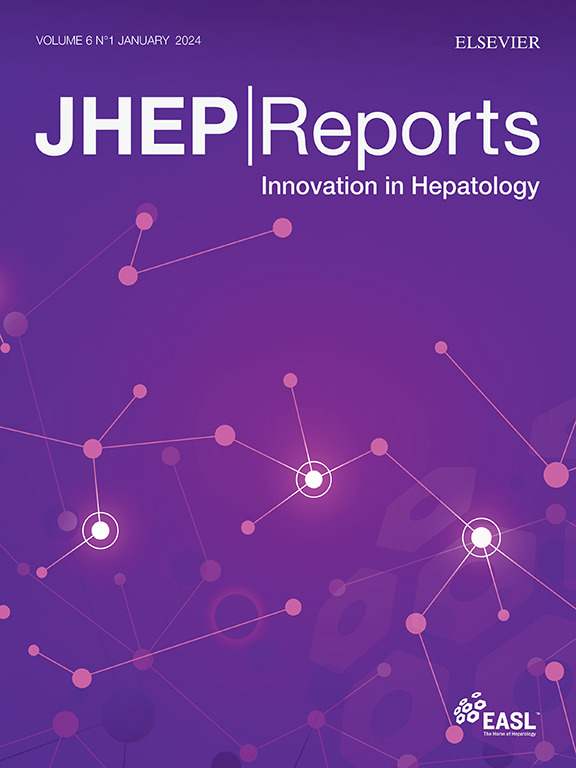无缺血肝移植可改善5年随访研究的长期预后
IF 9.5
1区 医学
Q1 GASTROENTEROLOGY & HEPATOLOGY
引用次数: 0
摘要
背景,目的无缺血肝移植(IFLT)是一种避免缺血再灌注损伤(IRI)的新技术。在这里,我们报告了第一个详细的5年随访结果。方法我们进行了一项队列研究,比较脑死亡(DBD)后捐献肝脏的IFLT和传统肝移植(CLT)受者的长期预后。主要目的是评估5年患者和移植物的生存。其他终点包括移植物损失、胆道并发症、排斥反应、感染和肝脏相关实验室检查。进行亚组分析以验证移植前肝细胞癌(HCC)患者结果的普遍性。结果共纳入168例患者,其中IFLT组38例,CLT组130例。5年患者生存率(86.84% vs. 56.92%;风险比[HR] 0.246, 95%可信区间[CI] 0.098 ~ 0.620;P <0.01)和移植物存活率(84.61% vs. 56.92%;Hr 0.307, 95% ci 0.131-0.719;p <0.01),与CLT组相比,IFLT组的发生率显著提高。在多因素分析中,IFLT成为5年患者生存的独立保护因素(HR 0.246, 95% CI 0.098-0.620;p & lt; 0.01)。相反,移植前HCC (HR 2.039, 95% CI 1.159-3.590;p <0.05),供体年龄(HR 1.022, 95% CI 1.001 ~ 1.040;p <0.05),扩展标准供体(HR 2.088, 95% CI 1.215-3.590;P <0.01)为患者5年生存受损的独立危险因素。在移植前HCC患者中,经HCC危险因素调整后,IFLT组的5年总生存率也显著高于CLT组(82.35% vs 42.03%;Hr 0.249, 95% ci 0.074-0.831;p & lt; 0.05)。长期(5年)随访数据表明,与CLT相比,在脑死亡供肝移植中,使用IFLT可能提高患者和移植物的生存率。影响和意义无化学肝移植(IFLT)已成为一种新的方法,旨在避免在移植手术的所有阶段发生IRI。已经证实,使用IFLT可以大大减少早发性移植物iri相关并发症。在这项对IFLT技术的首个5年随访研究中,我们证明,与传统肝移植相比,IFLT可以通过减少癌症复发来潜在地提高患者和移植物的长期生存。这项新技术有可能改变目前的临床实践,特别是在边缘移植和HCC患者中的应用。临床试验注册(ChiCTR-OPN-17012090)。本文章由计算机程序翻译,如有差异,请以英文原文为准。
Ischemia-free liver transplantation improves long-term outcomes in a 5-year follow-up study
Background & Aims
Ischemia-free liver transplantation (IFLT) is a novel technique designed to avoid ischemia–reperfusion injury (IRI). Here, we report the first detailed 5-year follow-up outcomes.
Methods
We conducted a cohort study comparing long-term outcomes between IFLT and conventional liver transplantation (CLT) recipients of livers donated after brain death (DBD). The primary objective was to evaluate 5-year patient and graft survival. Additional endpoints included graft loss, biliary complications, rejection, infections, and liver-related laboratory tests. Subgroup analysis was performed to validate the generalizability of the results in patients with pre-transplant hepatocellular carcinoma (HCC).
Results
A total of 168 patients were enrolled, with 38 patients in the IFLT group and 130 patients in the CLT group. Five-year patient survival (86.84% vs. 56.92%; hazard ratio [HR] 0.246, 95% confidence interval [CI] 0.098–0.620; p <0.01) and graft survival (84.61% vs. 56.92%; HR 0.307, 95% CI 0.131–0.719; p <0.01) rates were significantly improved in the IFLT group compared with the CLT group. In the multivariate analysis, IFLT emerged as an independent protective factor for 5-year patient survival (HR 0.246, 95% CI 0.098–0.620; p <0.01). Conversely, HCC before transplantation (HR 2.039, 95% CI 1.159–3.590; p <0.05), donor age (HR 1.022, 95% CI 1.001–1.040; p <0.05), and extended criteria donor (HR 2.088, 95% CI 1.215–3.590; p <0.01) were identified as independent risk factors for impaired 5-year patient survival. In patients with pre-transplant HCC, the 5-year overall survival rate of the IFLT group was also significantly higher than that of the CLT group after adjustment for HCC risk factors (82.35% vs. 42.03%; HR 0.249, 95% CI 0.074–0.831; p <0.05).
Conclusions
Long-term (5-year) follow-up data demonstrate that the use of IFLT potentially improves both patient and graft survival, when compared with CLT, in transplantation of brain-dead donor livers.
Impact and implications
Ischemia-free liver transplantation (IFLT) has emerged as a new approach designed to avoid IRI throughout all episodes of the transplant procedure. It has been confirmed that the use of IFLT can substantially reduce early-onset graft IRI-related complications. In this first 5-year follow-up study on the IFLT technique, we demonstrate that, compared with conventional liver transplantation, IFLT can potentially improve long-term patient and graft survival by reducing cancer recurrence. This new technique has the potential to change current clinical practice, particularly in the use of marginal grafts and in patients with HCC.
Clinical Trials registration
chictr.org (ChiCTR-OPN-17012090).
求助全文
通过发布文献求助,成功后即可免费获取论文全文。
去求助
来源期刊

JHEP Reports
GASTROENTEROLOGY & HEPATOLOGY-
CiteScore
12.40
自引率
2.40%
发文量
161
审稿时长
36 days
期刊介绍:
JHEP Reports is an open access journal that is affiliated with the European Association for the Study of the Liver (EASL). It serves as a companion journal to the highly respected Journal of Hepatology.
The primary objective of JHEP Reports is to publish original papers and reviews that contribute to the advancement of knowledge in the field of liver diseases. The journal covers a wide range of topics, including basic, translational, and clinical research. It also focuses on global issues in hepatology, with particular emphasis on areas such as clinical trials, novel diagnostics, precision medicine and therapeutics, cancer research, cellular and molecular studies, artificial intelligence, microbiome research, epidemiology, and cutting-edge technologies.
In summary, JHEP Reports is dedicated to promoting scientific discoveries and innovations in liver diseases through the publication of high-quality research papers and reviews covering various aspects of hepatology.
 求助内容:
求助内容: 应助结果提醒方式:
应助结果提醒方式:


